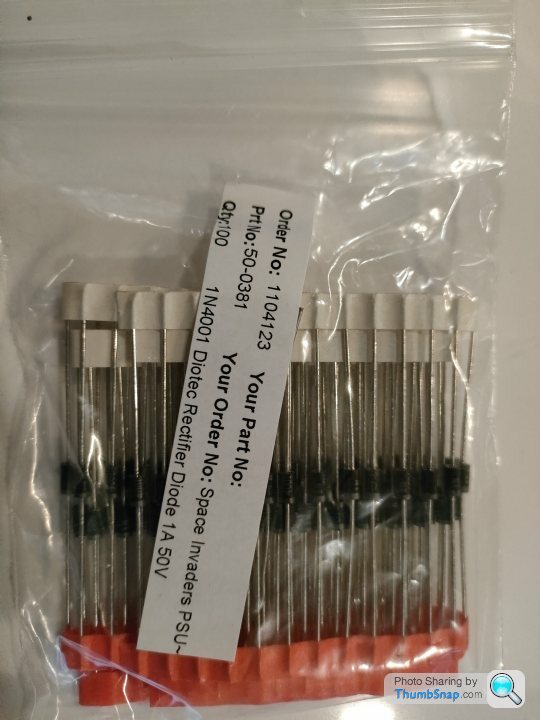Half the car is dead :-(
Discussion
Door Control - ECU investigation: Day 1
So the lovely people at TVR saw not only to use a hot glue gun to hold the PCBs in place on Door Control - ECU (DC-ECU) but also liberal amounts of super glue but armed with a trusty flat craft knife, and some patience I managed to slowly separate the case from the connector by sliding the blade down between the two and voila I can now get to both layers of PCB to check them out
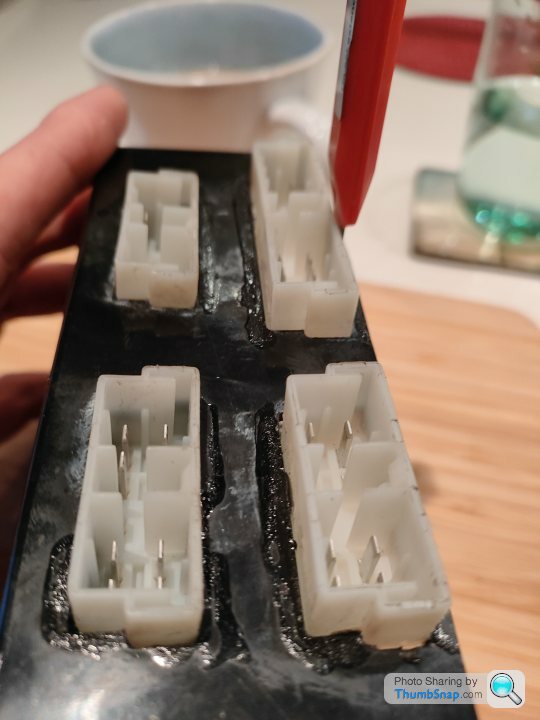
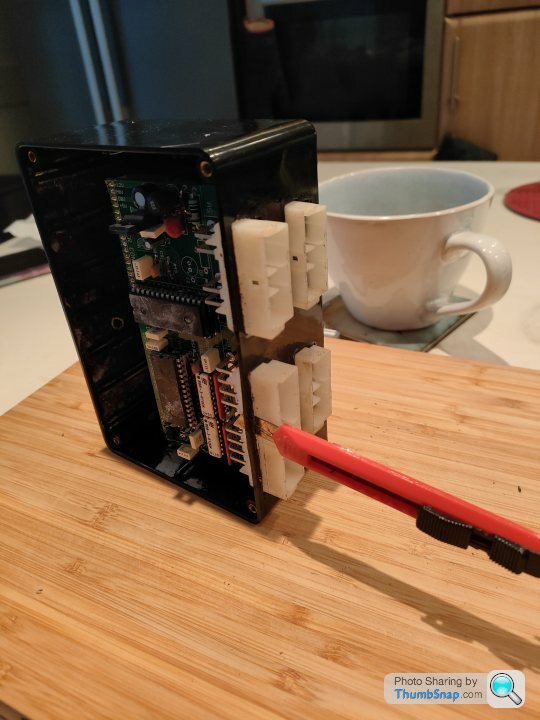
The top layer PCB contains all of the power conversion and logic chips to drive the doors and is primarily controlled by two programable PICs - one hand labelled "Door In" to handle the door closing, and the other "Door Out" to handle the door opening
There are a few other chips to smooth out the +12V power source and to provide the +5V power source needed by the TTL chips which are over near the TVR logo etched on the PCB
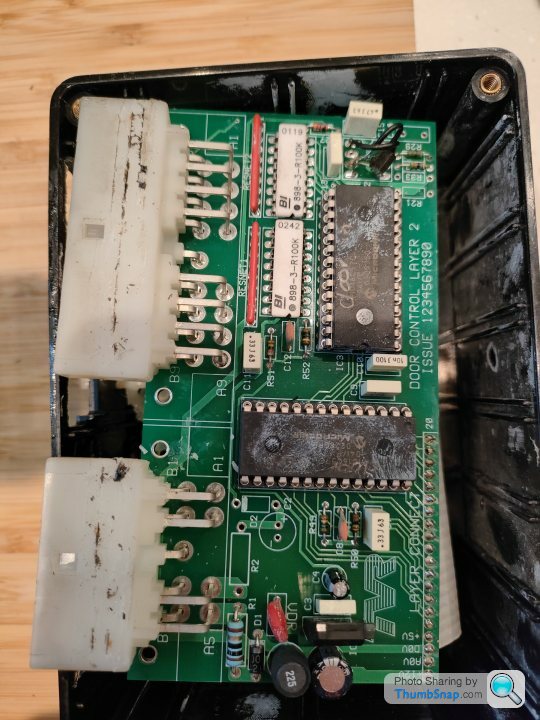
The lower board contains all of the micro relays needed to drive the doors such as for the window, lock etc. and would actually be very easy to design a replacement for as this is simple turned on and off by the PICs on the top as needed
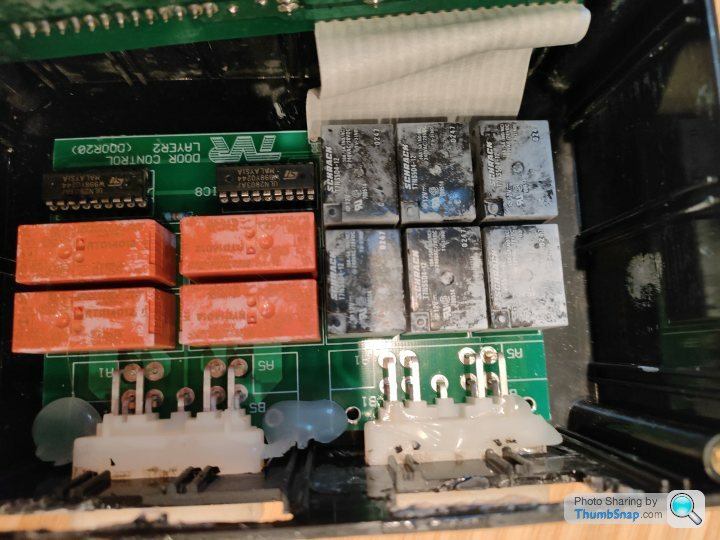
So I went sniffing around the boards for two reasons - one to fundamentally try and document what is on each PCB so I / we all have it for reference and b. to see if I could spot any likely contenders that might be why my board has stopped working since the fusebox imploded
The ST L7805CP - positive voltage regulator IC - just above the TVR logo etched on the top PCB is a possible contender as these normally overheat and then the front panel blows off as they are not being heat sinked enough, but this one looked OK even though there is no external heat sink which would probably help (*probably not on long enough to be needed to be honest)
However.. sniffing around over by the +12V input there is a +12V diode very like the one on the Lights / Indicator control box that I replaced that would be a likely candidate to be blown if it got power sent the wrong way through it
Diodes should allow power through in one direction and not the other and show this when tested using a multimeter with a diode setting, and on mine this is showing 0.587 in one direction which sounds right, so I think the next best thing is to rig it up to the car and follow the +12V around the board to ensure that it's getting converted correctly to +5V for the TTL chips and that they are getting power correctly
Here's my list of components from my initial investigations with a brief explanation of what they do next to them (for those that are interested)
Door Control ECU
Lower PCB
6 x Schrack T7NS5D4-12 (0247) - Minature Power PCB Relay
4 x RTD14012 - Power PCB Relay
2 x ST ULN2803A / W998Y0244 - Eight Darlington Arrays
Ribbon Cable
1 - +12V
2 - A0V
3 - D0V
4 - +5V
5 - IC4 pin 18 [RC0]
6 - IC4 pin 19 [RC1]
7 - IC4 pin 20 [RC2]
8 - IC4 pin 21 [RC3]
9 - IC4 pin 22 [RC4]
10 - IC4 pin 23 [RC5]
11 - IC4 pin 24 [RC6]
12 - IC4 pin 25 [RC7]
13 - IC4 pin 27 [OSC1]
14 - IC4 pin 17 [RB7]
15 - IC4 pin 16 [RB6]
16 - IC4 pin 15 [RB5]
17 - IC4 pin 14 [RB4]
18 - IC4 pin 13 [RB3]
19 - IC4 pin 12 [RB2]
20 - IC4 pin 11 [RB1]
Upper PCB
2 x Microchip PIC16C57 0228GR - EPROM/ROM-Based 8-bit CMOS Microcontroller Series
2 x BI 898-3-R100K - Dual-In-Line Thick Film Resistor Networks
2 x Resistor Nets (red near A1 and A9)
1 x ST WI8134 L7805CP - positive voltage regulator IC
1 x 10ohm resistor (near A5)
1 x VDR (red circular device near A5) - voltage-dependent resistor
1 x 12V diode
So the lovely people at TVR saw not only to use a hot glue gun to hold the PCBs in place on Door Control - ECU (DC-ECU) but also liberal amounts of super glue but armed with a trusty flat craft knife, and some patience I managed to slowly separate the case from the connector by sliding the blade down between the two and voila I can now get to both layers of PCB to check them out


The top layer PCB contains all of the power conversion and logic chips to drive the doors and is primarily controlled by two programable PICs - one hand labelled "Door In" to handle the door closing, and the other "Door Out" to handle the door opening
There are a few other chips to smooth out the +12V power source and to provide the +5V power source needed by the TTL chips which are over near the TVR logo etched on the PCB

The lower board contains all of the micro relays needed to drive the doors such as for the window, lock etc. and would actually be very easy to design a replacement for as this is simple turned on and off by the PICs on the top as needed

So I went sniffing around the boards for two reasons - one to fundamentally try and document what is on each PCB so I / we all have it for reference and b. to see if I could spot any likely contenders that might be why my board has stopped working since the fusebox imploded
The ST L7805CP - positive voltage regulator IC - just above the TVR logo etched on the top PCB is a possible contender as these normally overheat and then the front panel blows off as they are not being heat sinked enough, but this one looked OK even though there is no external heat sink which would probably help (*probably not on long enough to be needed to be honest)
However.. sniffing around over by the +12V input there is a +12V diode very like the one on the Lights / Indicator control box that I replaced that would be a likely candidate to be blown if it got power sent the wrong way through it
Diodes should allow power through in one direction and not the other and show this when tested using a multimeter with a diode setting, and on mine this is showing 0.587 in one direction which sounds right, so I think the next best thing is to rig it up to the car and follow the +12V around the board to ensure that it's getting converted correctly to +5V for the TTL chips and that they are getting power correctly
Here's my list of components from my initial investigations with a brief explanation of what they do next to them (for those that are interested)
Door Control ECU
Lower PCB
6 x Schrack T7NS5D4-12 (0247) - Minature Power PCB Relay
4 x RTD14012 - Power PCB Relay
2 x ST ULN2803A / W998Y0244 - Eight Darlington Arrays
Ribbon Cable
1 - +12V
2 - A0V
3 - D0V
4 - +5V
5 - IC4 pin 18 [RC0]
6 - IC4 pin 19 [RC1]
7 - IC4 pin 20 [RC2]
8 - IC4 pin 21 [RC3]
9 - IC4 pin 22 [RC4]
10 - IC4 pin 23 [RC5]
11 - IC4 pin 24 [RC6]
12 - IC4 pin 25 [RC7]
13 - IC4 pin 27 [OSC1]
14 - IC4 pin 17 [RB7]
15 - IC4 pin 16 [RB6]
16 - IC4 pin 15 [RB5]
17 - IC4 pin 14 [RB4]
18 - IC4 pin 13 [RB3]
19 - IC4 pin 12 [RB2]
20 - IC4 pin 11 [RB1]
Upper PCB
2 x Microchip PIC16C57 0228GR - EPROM/ROM-Based 8-bit CMOS Microcontroller Series
2 x BI 898-3-R100K - Dual-In-Line Thick Film Resistor Networks
2 x Resistor Nets (red near A1 and A9)
1 x ST WI8134 L7805CP - positive voltage regulator IC
1 x 10ohm resistor (near A5)
1 x VDR (red circular device near A5) - voltage-dependent resistor
1 x 12V diode
Edited by Juddder on Sunday 5th December 19:48
From my side I wanted to test the power circuit of the Door / Window ECU so I grabbed a handy 12V switcher and rigged up some crimps to the main PCB power points (the two wire plug on the top circuit) and tested around
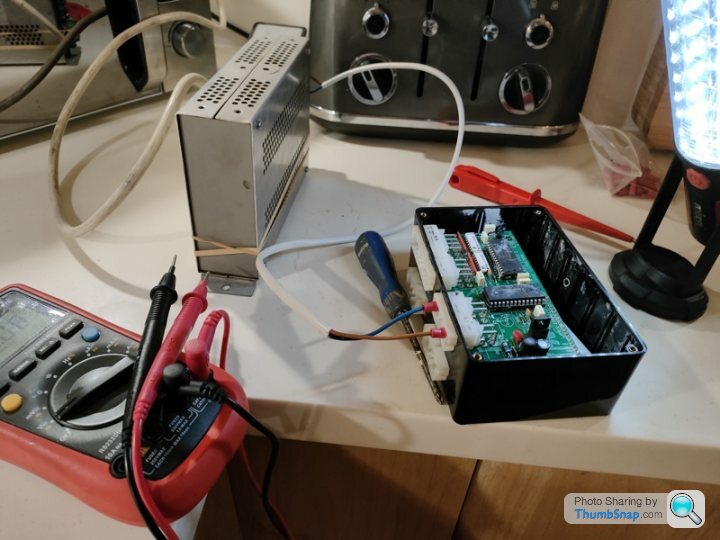
The good news is we are getting +12V flowing through the board correctly (+12V on the flow side of both the first resistor, and the diode) and +11.5V when it gets down to the second board ribbon connector so that should be correct to power the relays as needed
The +5V is good too so the TTL chips should be powering fine - I need to read up the datasheet on those and check which pins are Vdd (+5V) and Vss (GND) - actually just did that and it's pins Vdd = 2 and Vss = 4
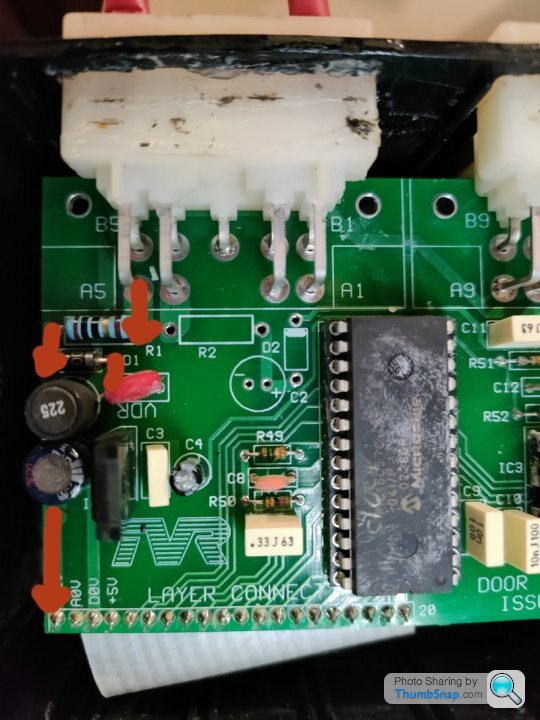
Oh, and interestingly you can see that there are layouts for mirrored power circuitry on A4 too (*maybe as a backup or similar?)

The good news is we are getting +12V flowing through the board correctly (+12V on the flow side of both the first resistor, and the diode) and +11.5V when it gets down to the second board ribbon connector so that should be correct to power the relays as needed
The +5V is good too so the TTL chips should be powering fine - I need to read up the datasheet on those and check which pins are Vdd (+5V) and Vss (GND) - actually just did that and it's pins Vdd = 2 and Vss = 4

Oh, and interestingly you can see that there are layouts for mirrored power circuitry on A4 too (*maybe as a backup or similar?)
Penelope Stopit said:
Surely the Optocoupler LEDs will fail due to over voltage or is there something I'm missing
How about just putting a voltage regulator on the supply that will smooth out the +12V - +14V to provide a constant +12V whatever the state of the alternator / battery charge etc.?A cheapy buck/boost +12V regulator should do the trick and that would smooth out any fluctuations and prevent any harm to the optocouplers
Something like this guy would potentially do the job or one could add a more snazzy one with LCD display of voltage, just for fun

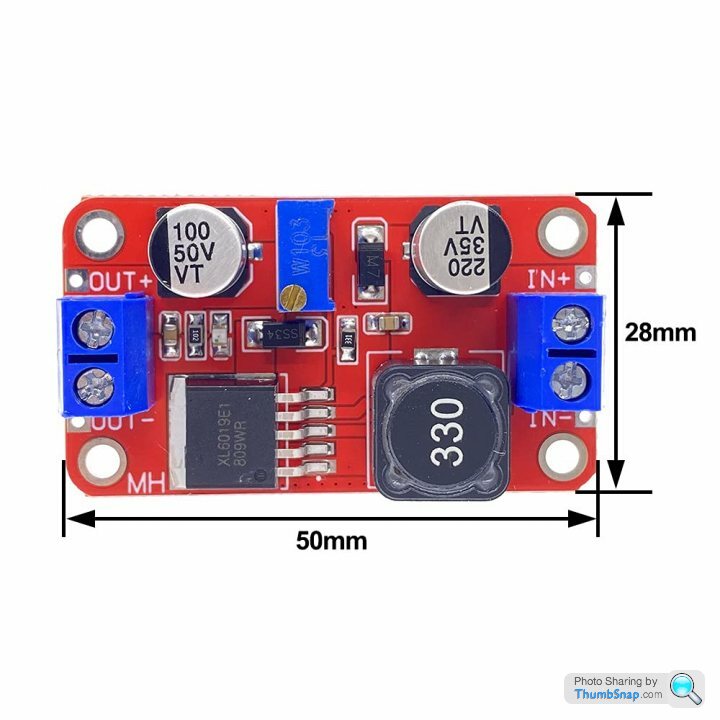
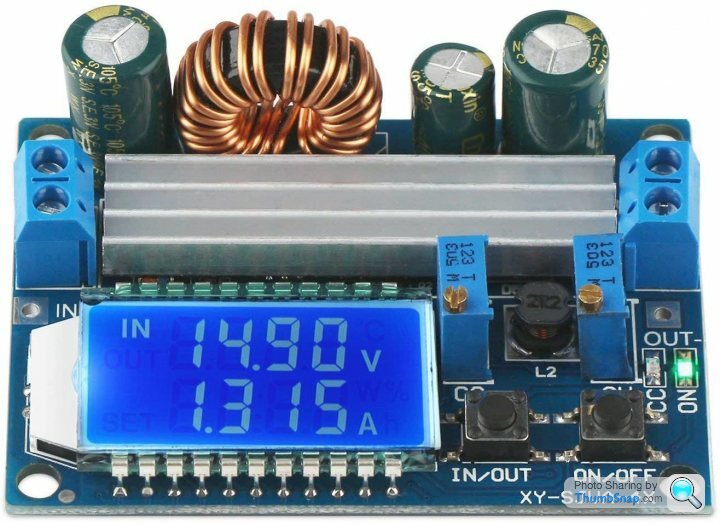
Edited by Juddder on Friday 3rd December 12:46
DuncanM said:
A question for Judder and Penelope:
Are the TVR ECUs that bad (generally, not just lights) ? If so, what reasons do you think TVR had for using them?
I'll answer this question about the Door Control Box as Penelope is much more informed about the lights and dim / dip boxes than I am Are the TVR ECUs that bad (generally, not just lights) ? If so, what reasons do you think TVR had for using them?

Looking at the Door Control Box yes it's actually pretty well made
TVR were pretty on the ball to use a "powerful (200 nanosecond instruction execution) yet easy-to-program (only 33 single-word instructions) FLASH-based 8-bit microcontroller" [*marketing blurb taken from Microchip who make the PIC] and they've actually made the boards pretty well with nice things such as sockets for the PICs to go into (*cheapskates just solder the chips straight to the PCB)
It just feels like they didn't expect people to be still maintaining them
I'll add an update post below about what I've been doing with the microcontrollers

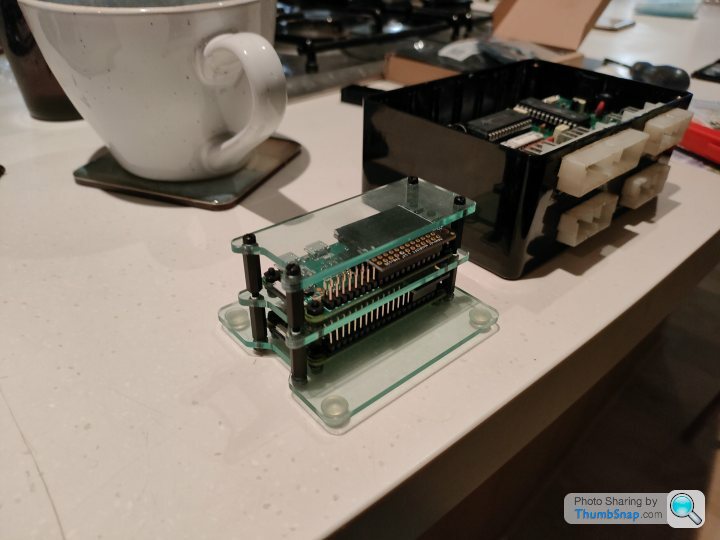
Edited by Juddder on Sunday 5th December 18:46
Door Control - ECU investigation: Day 2
So in order to rule out the PIC16C57C chips from being the problem with the Door Control Box I read through the datasheet for my MiniPro EPROM reader and it turns out it can read the program from them to verify they are alive
Also, strangely a past version of me must have predicted this happening as I bought from eBay a few years ago two chips that were advertised as "ex-TVR factory Cerbera Door Control ECU chips" and stuck them in a drawer for a rainy day
Therefore as we now have two chips, we can use one as the comparison for the other, read them both and then verify the data read against the other one to validate that the chips are a. working and b. the same code
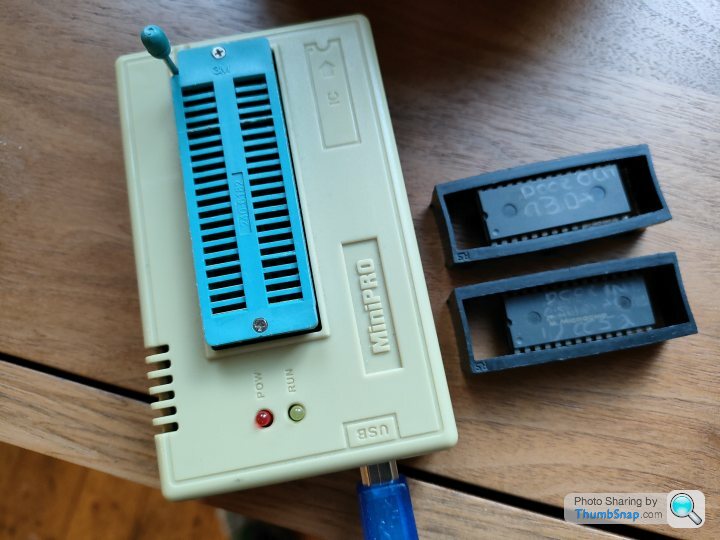
The miniPro software only runs on Windows so I'm running a VM of Windows on my Mac but as you can see from the screen shot below the verification of the first Door Out chip from my backup set versus the Door Out chip from the Door Control Box is verified as identical so it looks like they are actually fine
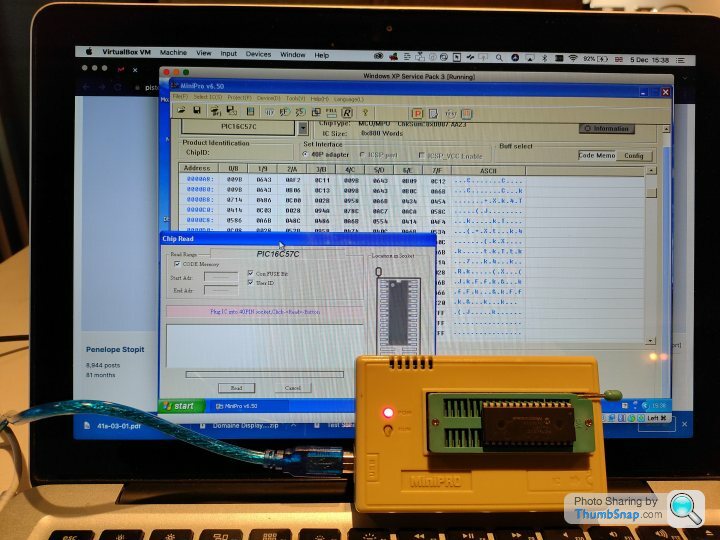
On the ex-factory chips the programmer had very helpfully written on the chip in pencil the checksum / user ID of the chip, which according to the datasheet are 4 programmable locations that are used to verify that what is written to the chip matches the original program code uploaded
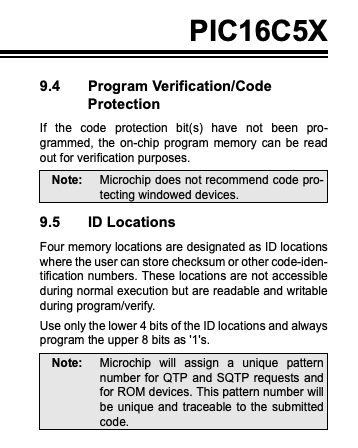
On the Door Out chip this is 93DA and as you can see from the second shot below when I read the chip contents we can see an exactly matching number in the Used ID Word section of the chip read details. This proves that we've read the contents of the PIC correctly
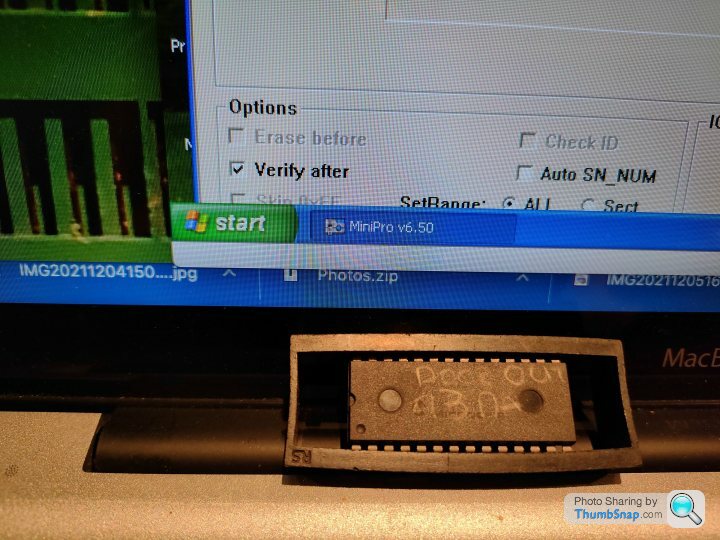

Door In has "ID 0052" written on it and that matches the 4 User ID values when we read that one in too, so that's all good as well
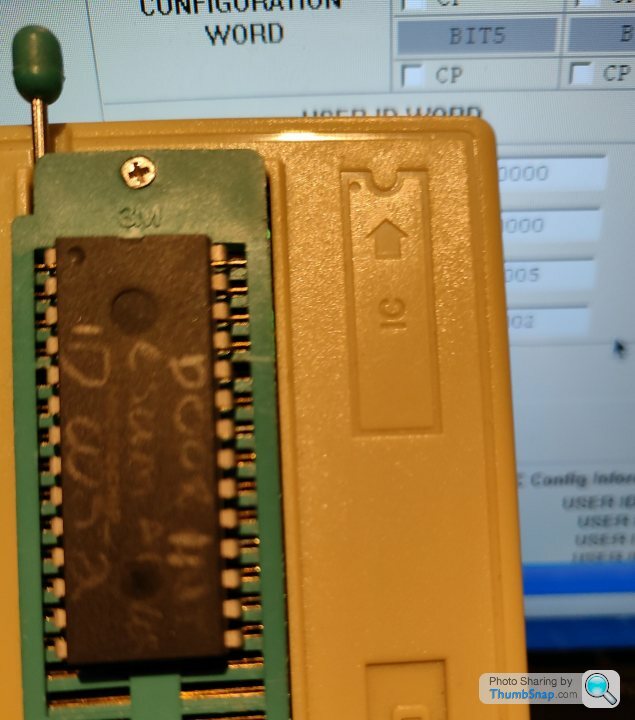
While I had the chips out I took some high resolution shots of the PCB layer as many of the traces are hidden under the chips when in situ so that I can trace which pins of the PICs are triggering the relays to open the door latch, drop the window etc and which pins are being used for the inputs such as the door open button etc.
My cunning plan if the Door Control ECU still refuses to come back to life with more investigation it to replace this top board with an Arduino or similar, and then write my own code to trigger / emulate the same sequences as the current PICs do with the relays for opening and closing the doors
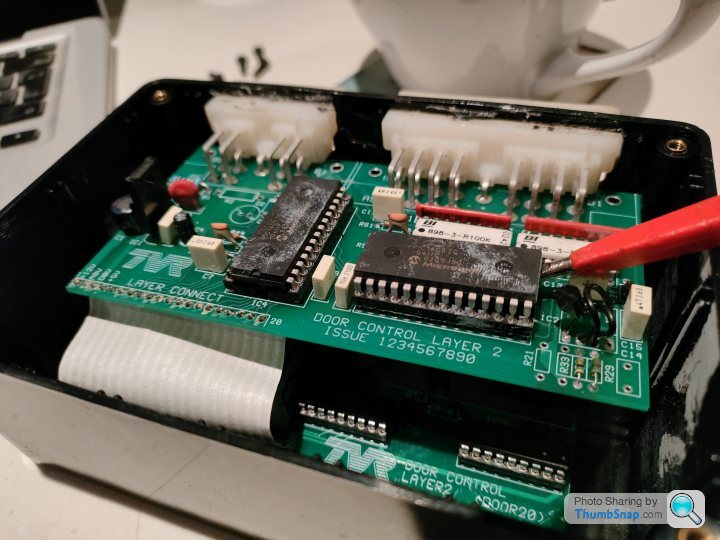
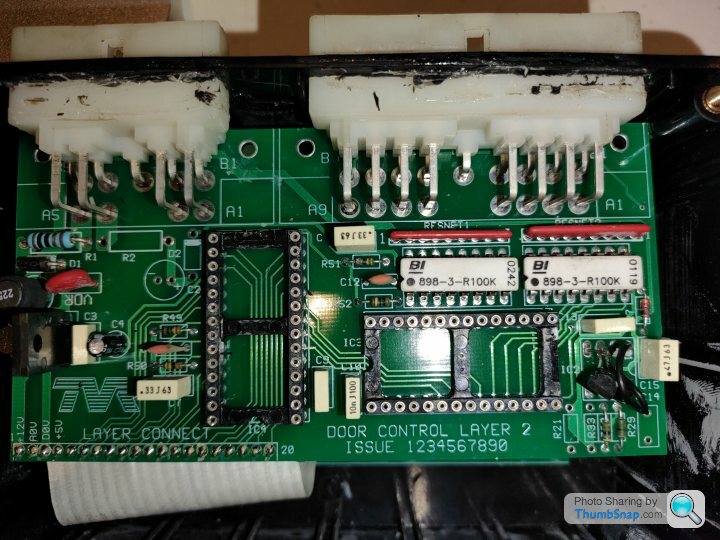
So in order to rule out the PIC16C57C chips from being the problem with the Door Control Box I read through the datasheet for my MiniPro EPROM reader and it turns out it can read the program from them to verify they are alive
Also, strangely a past version of me must have predicted this happening as I bought from eBay a few years ago two chips that were advertised as "ex-TVR factory Cerbera Door Control ECU chips" and stuck them in a drawer for a rainy day
Therefore as we now have two chips, we can use one as the comparison for the other, read them both and then verify the data read against the other one to validate that the chips are a. working and b. the same code

The miniPro software only runs on Windows so I'm running a VM of Windows on my Mac but as you can see from the screen shot below the verification of the first Door Out chip from my backup set versus the Door Out chip from the Door Control Box is verified as identical so it looks like they are actually fine

On the ex-factory chips the programmer had very helpfully written on the chip in pencil the checksum / user ID of the chip, which according to the datasheet are 4 programmable locations that are used to verify that what is written to the chip matches the original program code uploaded

On the Door Out chip this is 93DA and as you can see from the second shot below when I read the chip contents we can see an exactly matching number in the Used ID Word section of the chip read details. This proves that we've read the contents of the PIC correctly



Door In has "ID 0052" written on it and that matches the 4 User ID values when we read that one in too, so that's all good as well

While I had the chips out I took some high resolution shots of the PCB layer as many of the traces are hidden under the chips when in situ so that I can trace which pins of the PICs are triggering the relays to open the door latch, drop the window etc and which pins are being used for the inputs such as the door open button etc.
My cunning plan if the Door Control ECU still refuses to come back to life with more investigation it to replace this top board with an Arduino or similar, and then write my own code to trigger / emulate the same sequences as the current PICs do with the relays for opening and closing the doors


Edited by Juddder on Sunday 5th December 17:09
Edited by Juddder on Sunday 5th December 19:49
So while tracing out the pins to the IC4 which is the PIC that connects to the lower relay PCB I noticed this in the right hand corner of the board that looks very much like a blown resistor or diode 
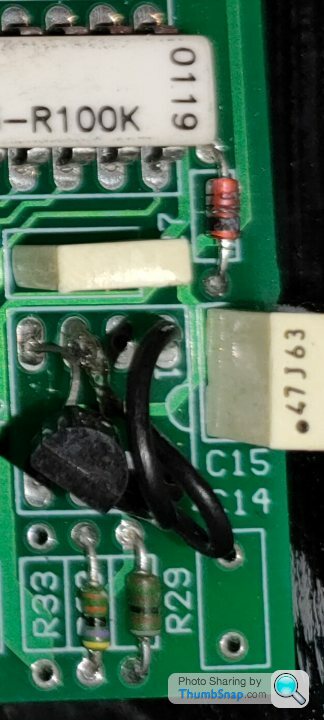
I've circled it in Orange below
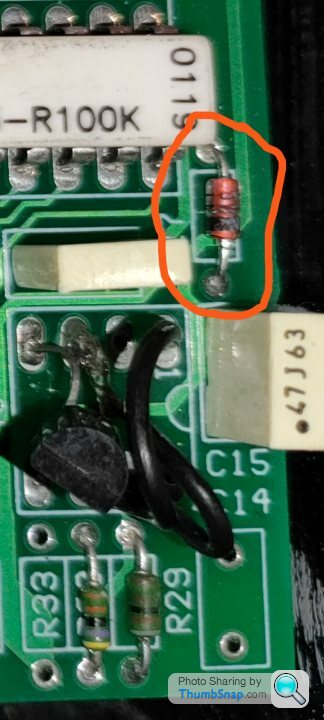
Hopefully the PCB designer was a good electronics citizen and put the value of what it is (I think it says R7 next to it from the shot so should be a resistor) underneath the component on the PCB so I will desolder it tomorrow and see what it says
@Penelope Do you know what the IC circled in blue was meant to be? Looks like they've bodged a transistor in there with some jumper wires instead (*note to post above about good board design - looks like they ran out of components so just did the same as the TTL chip would do with a transistor and some wires - not beautiful!)
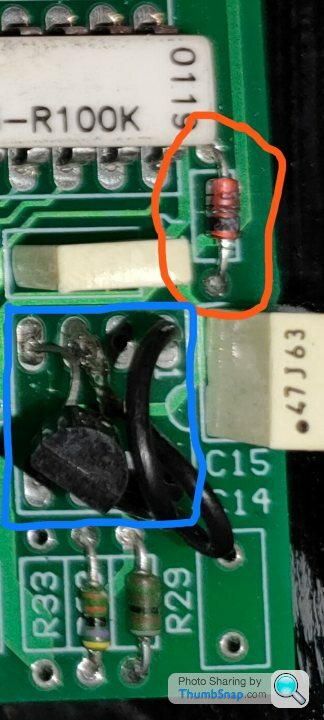
Note to anyone doing investigations like this - take lots of high res photos as you can study them and try and visually see where the problems are. When I initially opened the Door Control ECU it had that melted chip smell in there so I knew that it was highly likely something somewhere was blown on the board...


I've circled it in Orange below

Hopefully the PCB designer was a good electronics citizen and put the value of what it is (I think it says R7 next to it from the shot so should be a resistor) underneath the component on the PCB so I will desolder it tomorrow and see what it says

@Penelope Do you know what the IC circled in blue was meant to be? Looks like they've bodged a transistor in there with some jumper wires instead (*note to post above about good board design - looks like they ran out of components so just did the same as the TTL chip would do with a transistor and some wires - not beautiful!)

Note to anyone doing investigations like this - take lots of high res photos as you can study them and try and visually see where the problems are. When I initially opened the Door Control ECU it had that melted chip smell in there so I knew that it was highly likely something somewhere was blown on the board...

RayTVR said:
For relay circuits like this board, general purpose diode like IN4001 would be the correct component.
(I think it may work but not sure but better to have correct references for future)
Yes - good point - hadn't clocked the Zener part in the product title in my rush to order a replacement - I'll see what other diodes I have around and see if any of them will be a better replacement.(I think it may work but not sure but better to have correct references for future)
As you say the Zener will still work as it will conduct in the required direction, it's just might not do the blocking in the other direction if it gets > 12V+ in the other / wrong direction (if my understanding of Zener diodes is correct!)
Penelope Stopit said:
Have no idea, although sometimes having to dabble with electronic circuits I have no idea how this circuit is built
It's all very interesting though
I think it might provide the clock for the PICs as they need a timing circuit on pin 27 if I am reading the datasheet correctly and the space for the IC is the same size as a 555 timer - also being a transistor with various capacitors and resistors connected to it it would lend itself to be a timer of some sortIt's all very interesting though
Something like this...
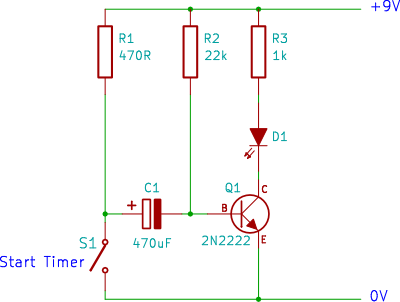

So tomorrow I'm going to try and get to the Steering Wheel ECU as well as the behaviour of the water pump staying on all of the time, and the steering wheel buttons not working is very reminiscent of this being blown / disconnected as well as referenced in this thread
In my car Fuse 7 provides power to the steering ECU & the effect of the fuse blowing is that the wipers and washer pump stick on, the main beam sticks on, steering wheel button's don't work among other weirdness. Therefore lack of power to the steering ECU seems to result in some strange behaviour from it.
The location is described as being velcro'd to the inside of the lower steering wheel cover panel, which I'm guessing is the panel highlighted in the picture below with the arrow?
If so the helpful post above says there is a wing nut on the back so I'm guessing getting in there with a torch and looking to the back where one's knees usually are is probably around where it will be?
Anyone doing this before tips appreciated
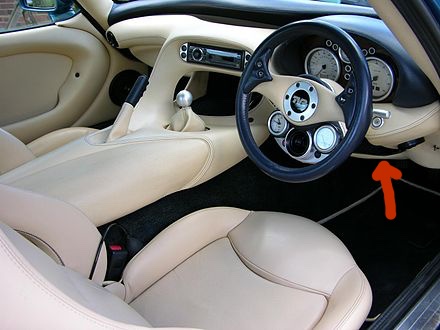
In my car Fuse 7 provides power to the steering ECU & the effect of the fuse blowing is that the wipers and washer pump stick on, the main beam sticks on, steering wheel button's don't work among other weirdness. Therefore lack of power to the steering ECU seems to result in some strange behaviour from it.
The location is described as being velcro'd to the inside of the lower steering wheel cover panel, which I'm guessing is the panel highlighted in the picture below with the arrow?
If so the helpful post above says there is a wing nut on the back so I'm guessing getting in there with a torch and looking to the back where one's knees usually are is probably around where it will be?
Anyone doing this before tips appreciated


Gladers01 said:
The component circled in orange looks more like a zener diode than a resistor and the bodged transistor circled in blue could have been fitted with an opto- coupler for isolation/screening purposes in a previous life. All these blown components are only to be expected if the modules have been subjected to a large over voltage or reverse polarity shoved up their jacksy, interesting thread all the same 
Yes I thought the same is it definitely doesn't look like a resistor but from a few more high resolution shots it is definitely labelled 'R27' and the 47n100 capacitor next to it is C13
R27 could refer to the 898-3-R100K 100K resistor network and array white chip next to it but it doesn't seem quite right as the label is much more over towards the scorched component
I also measured the resistance of all the resistors around this part of the circuit and both R27 and R29 (left and bottom left of photo) both measured resistance across them of 8.16k (I will double check this) - but hopefully when I desolder it it will be easier to see (the other boxes have the direction of the diode on the PCB so hopefully that will help) [note: from studying the high resolution image below it looks like their is no diode polarity markings under the chip]
Maybe they switched the resistor for a diode to go with the swap of the transistor for the 6 pin chip where the bodged wiring is...
If anyone has a copy of the PCB layouts or the schematics that would be amazing, or even a few shots of another Door ECU PCB if anyone ever took any just to do some comparisons

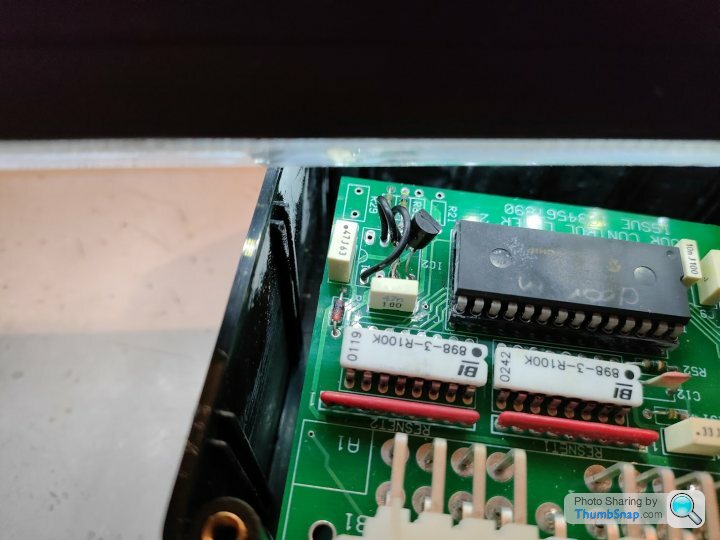
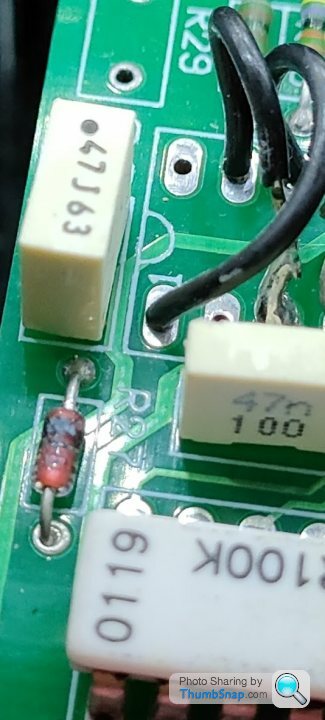
Update:
So I took the best high resolution images my camera phone can do of the component and it's pretty much definitely a

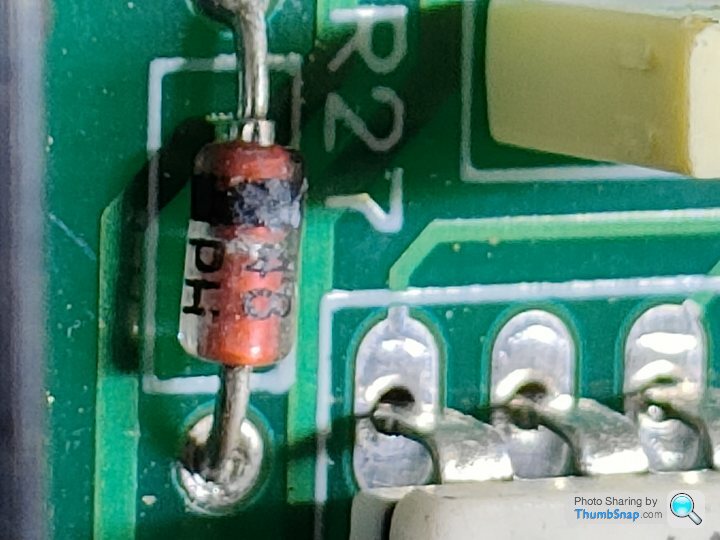
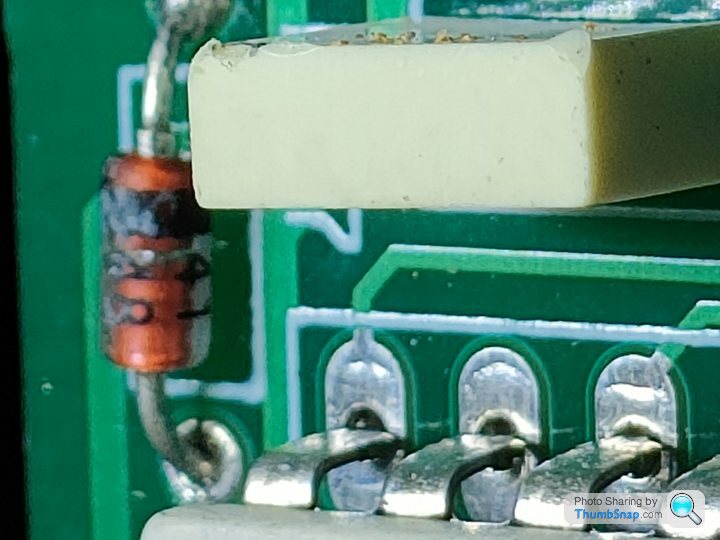
and here's a reference image from the ones I have clearly showing the 1N and the 41 and you can see the 41 and the slightly burnt 48 in the photos above

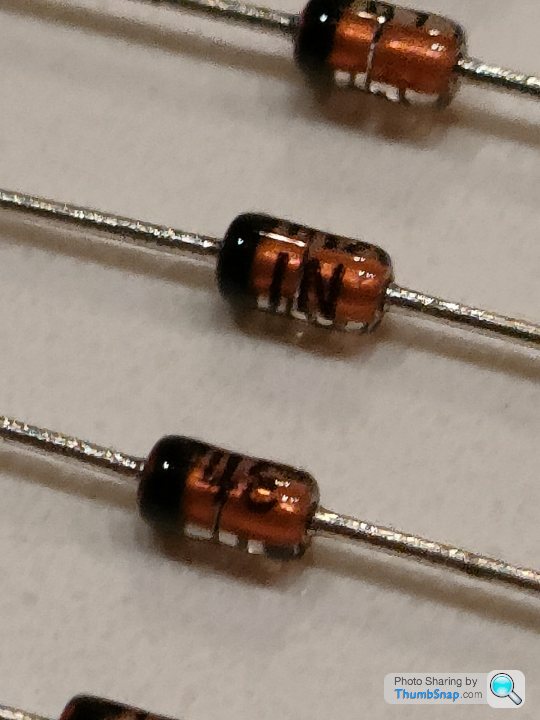 |https://thumbsnap.com/hZWFgJWr[/url]
|https://thumbsnap.com/hZWFgJWr[/url]Edited by Juddder on Tuesday 14th December 17:31
Penelope Stopit said:
Have you managed to work out what could possibly have caused the above ECUs to fail?
Hadn't given the cause much thought until recently
Something, well much more than something suggests to me that there are underlying problems yet to be discovered
No not yet to be honest - had in my head thought that the fusebox falling backwards into the wheel arch might have caused it to find something metal to short a +12V on, and I think I replaced fuse 13 as maybe that blew too (it's been and continues to be a long journey so it's hard to completely remember!)Hadn't given the cause much thought until recently
Something, well much more than something suggests to me that there are underlying problems yet to be discovered
On your inklings of there are further problems to come, wait for the next post...

Byker28i said:
Shout if you need any photos and I'll take some for you
That's great, many thanks and yes it was your post I referenced above so that's been super helpfulYesterday I managed to get in the drivers footwell of my car and found the wing nut you mention and took a photo of it just so any future selves can reference it - you can see it on the right middle in this photo to the diagonal top right of the top of the accelerator pedal
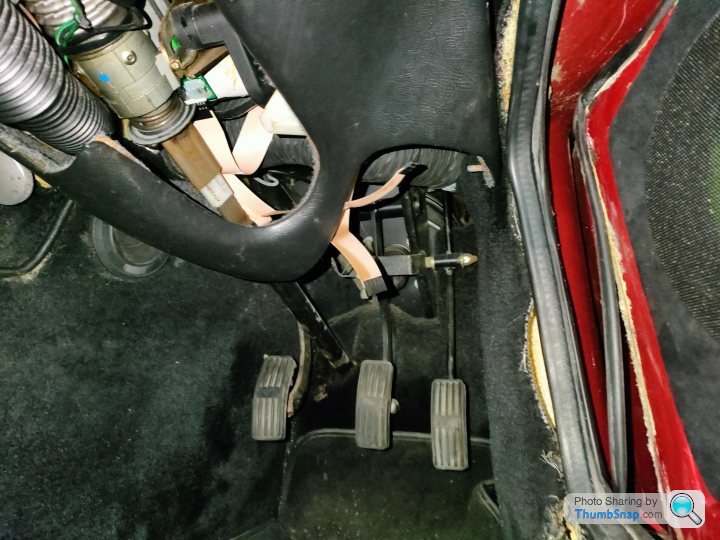
Attached to the back is the Steering Wheel ECU which is even more of a fudge job that the boxes in the boot - mine is hand-cut to fit the plugs and only had three screws in it - you can see the 9x9 connector with keyed pin as per the other boxes for the high current inputs and outputs, the 10 pin head connector for the steering wheel ribbon that the steering wheel buttons connect to and the 5 pin head connector for the indicator stalk and hazard button
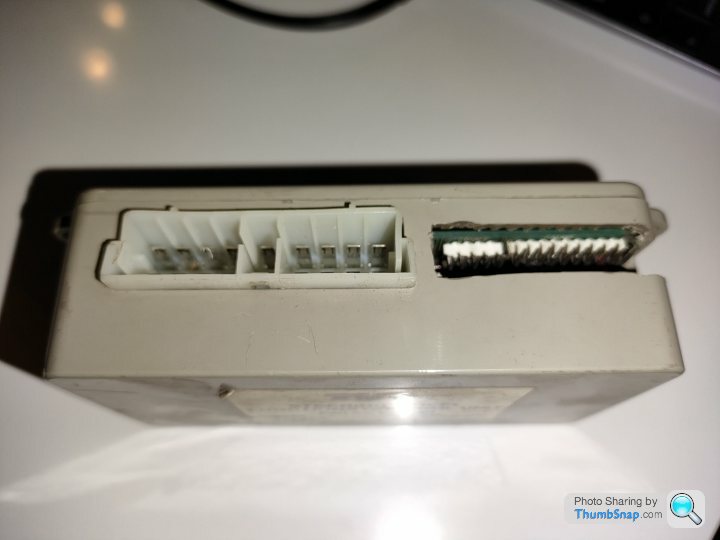
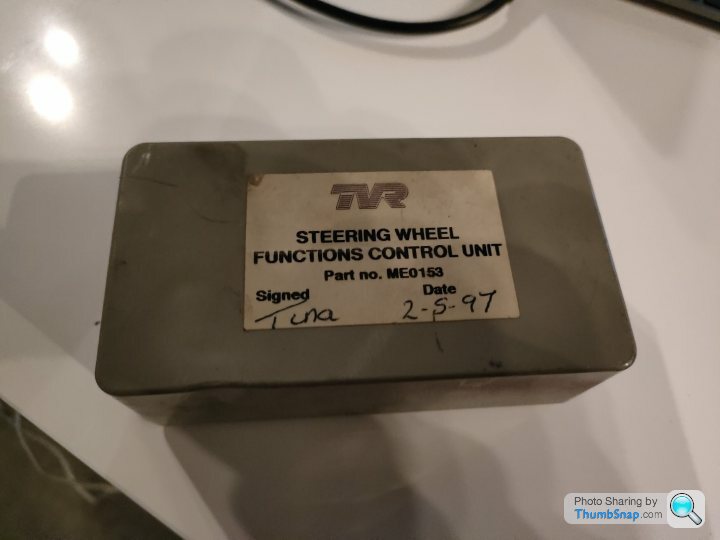
On closer inspection I think I've figured out why mine isn't working...
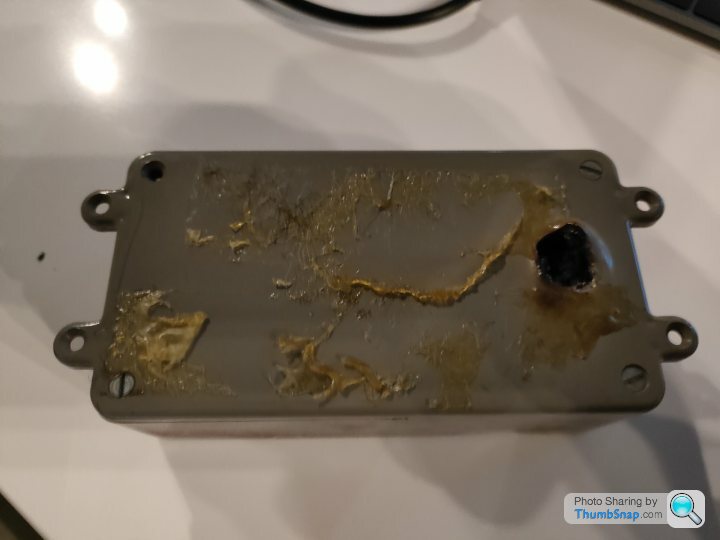
For something to melt like that means it a. wasn't fused and b. didn't like getting 12V shorted through it so time to open it up and have a look...
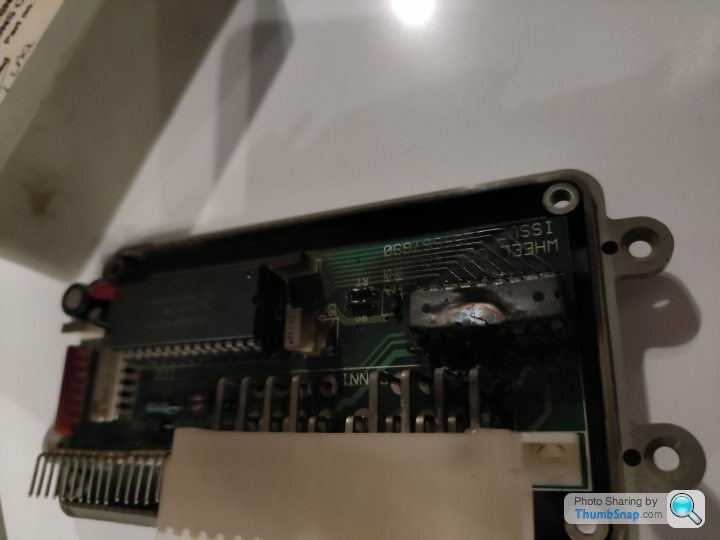
As you can see there is a TTL chip over by the high current 9x9 connector that has literally melted with the voltage and burnt through the PCB on the way - I've seen them crack before but never quite melt like this!
The good news is we can see the wiring traces, and the PIC (*same as Microchip PIC16C57C used on the Door ECU) so we can read that to download the ROM code and potentially either jumper the wires or do similar where the PCB has melted
I think I should also be able to emulate / do similar behaviour to this box with an Arduino, a +12V to +5V transformer and some relays so I'm going to have a think and see what will work best - might be better just to start with a new circuit and some more modern electronics...
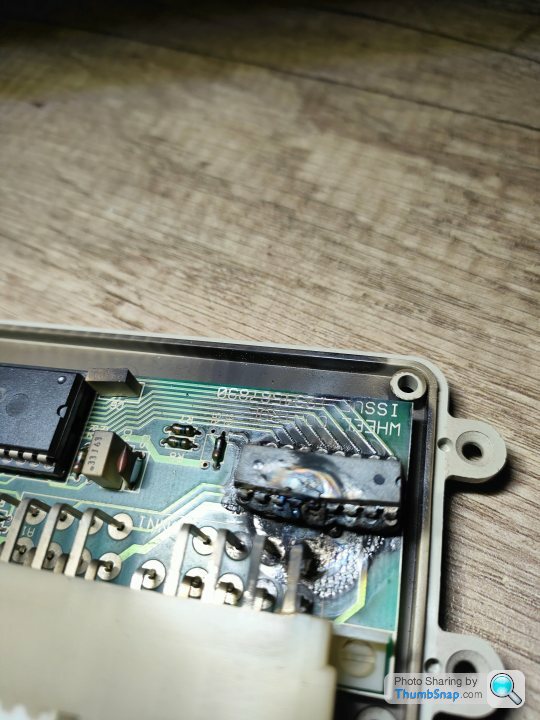
and this is the part of the main harness wiring diagram I'm going to need which shows the Steering Column connector as per Biker's diagram above and the Steering Column ECU which is the part I will need


and here's the connections for the signal and high current drive part of the ECU
A1 - N/C
A2 - Headlamp Signal (V)
A3 - N/C
A4 - N/C
A5 -
A6 - Wiper 2 Signal (R/S)
A7 - Main Beam Signal (U/W)
A8 - Dip Beam Signal (U/S)
A9 - Turn Left Signal (?)
B1 - Ignition (O)
B2 - Horn Drive (F/S?)
B3 - Hazard Drive (W/R?)
B4 - Battery (R)
B5 - Earth (B)
B6 - Wiper 1 Signal (V/O?)
B7 - N/C
B8 - Washer Signal (U/V)
B9 - Turn Right Signal (G/W?)
Notes:
A2 is connected to Dash Switch A5 Headlamp Signal, and thus J30 (to rear harness) pin 19
Most of the other signals also feed into J30 for travel to the ECUs in the rear
Edited by Juddder on Thursday 16th December 16:48
Byker28i said:
There's a few of the indicator and hazard units for sale on ebay, all from Douglas Valley Breakers, for around £55-60. Worth asking if he has a steering wheel functions unit for the same sort of price which would save you some work?
Yes many thanks and good idea 
I already bought from them the last Ignition ECU they had and an extra Hazard / Lights ECU a couple of weeks ago when I started on this journey so I think I have everything from them they have that will help unluckily. Another suggestion was to try TVR Glen so I will ping him / them a message today and see what they might have
FarmyardPants said:
What percentage of the car is still dead?  Any updates?
Any updates?
Well I've been away from the car for nearly a month with Christmas etc. but I have been working on building my own Door Control ECU to replace the ones that TVR made out of an Arduino Mega and a daughter relay shield Any updates?
Any updates?I've pretty much finished the programming and now need to get to the hardware and do some actual testing so I will report back when I have - it might be in a couple of weekends with a bit of luck :-) [edit: probably longer as I have no idea how well this will work or not
 ]
]Here's a sneak peak...
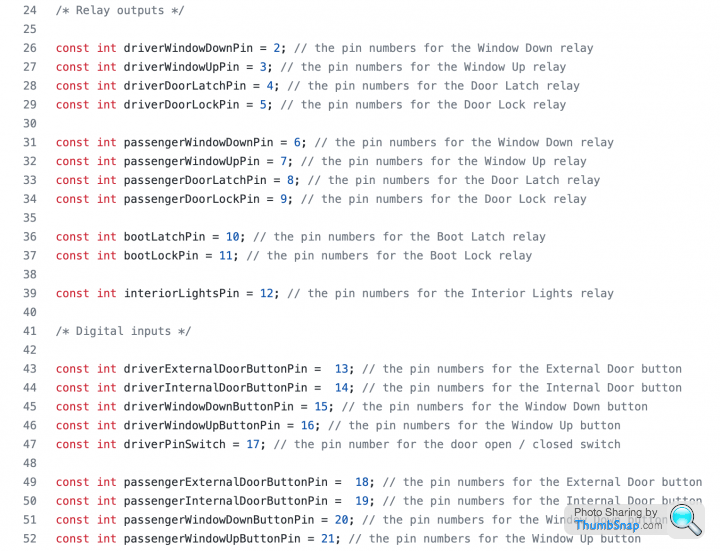
and we can copy and potentially improve the door opening process of the original Door ECU box and maybe even add some nice things like flashing the headlights or similar

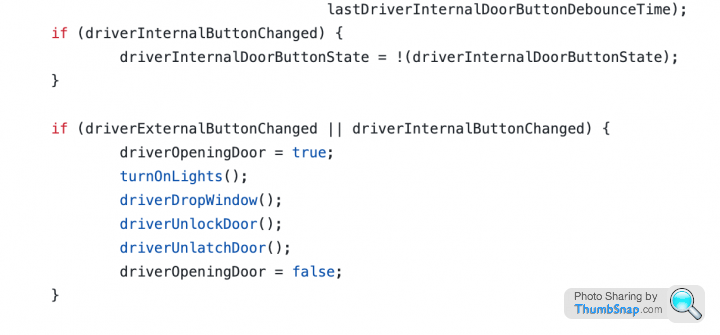
Edited by Juddder on Wednesday 5th January 14:27
FarmyardPants said:
Sounds like a fun project. Will it integrate with the existing immobiliser or are you going to incorporate the concept of locking and immobilising into the code? ... But it's quite cool to walk up to the car with the remote in your pocket and have the door pop open before you get there 
That does sound cool and yes thinking about it I could potentially add an IR module to the Arduino to add as a 3rd door button press for each door
My plan with the immobiliser is to find an alarm switched +12V feed and use that to power the Arduino so that it's not powered on all of the time and draining battery power from the main +12V feed
The boot time of an Arduino without a boot loader is < 0.5s [reference here] so it should in theory be fast enough to respond with no lag once the alarm is disabled, and you then press the door button - I would imagine even with a boot loader at ~2s it's probably not too bad
All things to try out when I have some hardware connected and bits of the car to try out - I will report back...

Byker28i said:
Hum, you joke, but as arduinos have stacking interfaces.... Is there a possibility of replacing multiple boxes with just one?
I may have to dig mine out. Last used for a light wand for writing words on long exposure photos...
OK - as everyone seems quite excited and doesn't think I'm completely mad it's time for a bit of show and tell... I may have to dig mine out. Last used for a light wand for writing words on long exposure photos...

So for testing I'm going to use either a Arduino Mega or Uno with a Seed Studio Relay Shield as per this
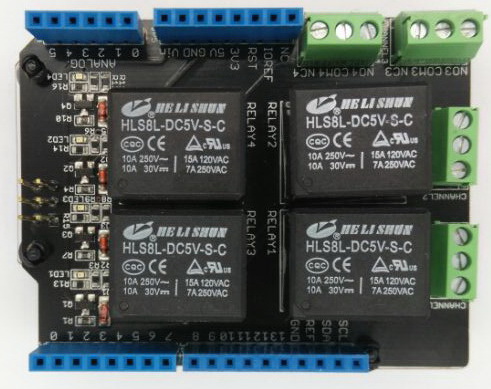
There's only 4 relays on this, but I can test the mechanism for the drivers door if I rig up driver door latch, driver door lock, window up and window down
Once I have this working it's either plugging in another one of these for the passenger door, using the same program but just with the inputs for the passenger connectors connected, or moving over to my master plan which is one of these...
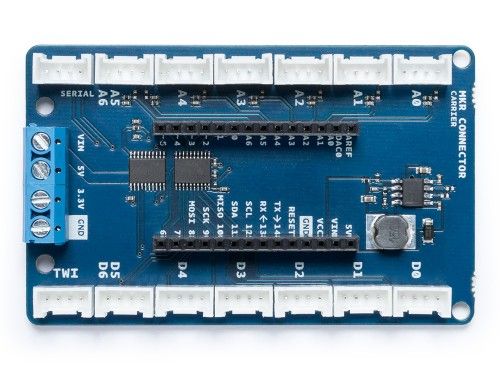
With the Seeed Studio Grove shield I can connect 14 of these each with a relay which basically covers all of the
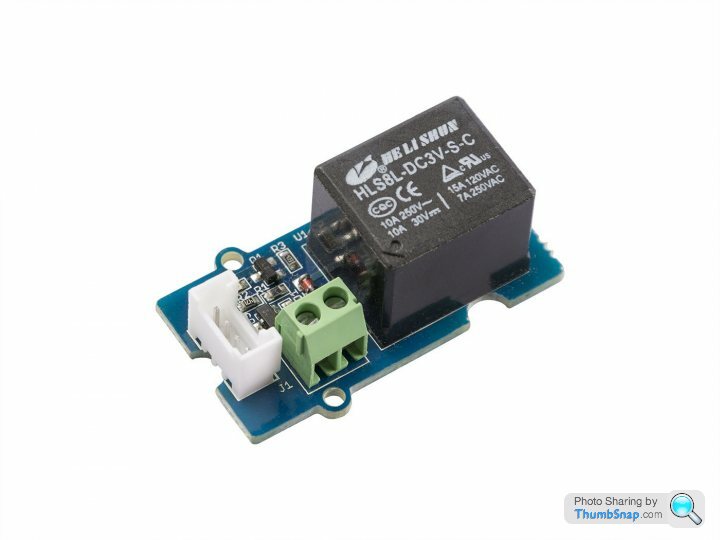
We can also use the Grove kit with hubs for extra ports (*we'll need input ports as well for the buttons etc.) and potentially even add super crazy stuff like fingerprint detection or accelerometers (*but that's not my intent at this point, just to get my car working again
 )
)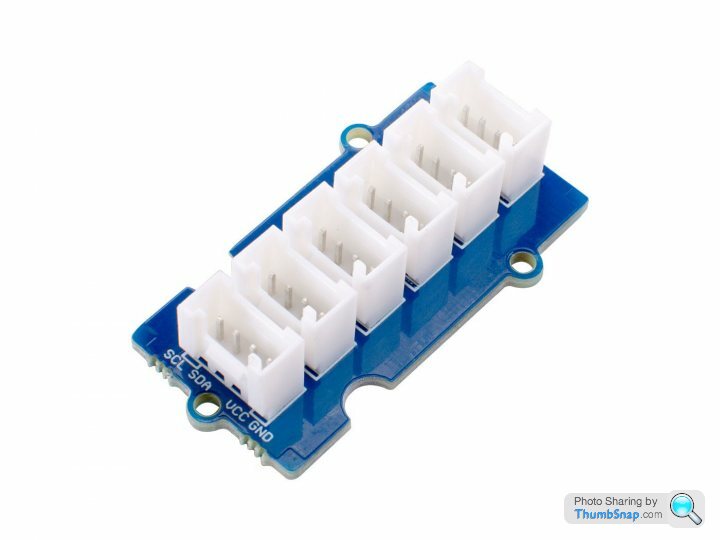
Bear with me as I've been writing the code blind as I wait for the hardware to arrive but it compiles and runs and all of the test suite for each function seems to do what I want.
Hardware should be united with me when I'm back in the UK next week, including buck-boost adapters for the +12V supply to drop it to +5V for the Arduinos so I can try some actual switching of 12V electrics and see how we get on and then I'll post up the GitHub link for others to play along too

Edited by Juddder on Friday 7th January 16:31
Penelope Stopit said:
Are we all to sit back and watch or are you open to input?
Yes please - I'm just working away on my own so all input very welcomeI'll also share the Arduino ECU diagnostics I built when I was working with Ade (RSAJP) and Greg (OSAJP) on an Arduino version - shows what these little Arduinos can do with a shield or two

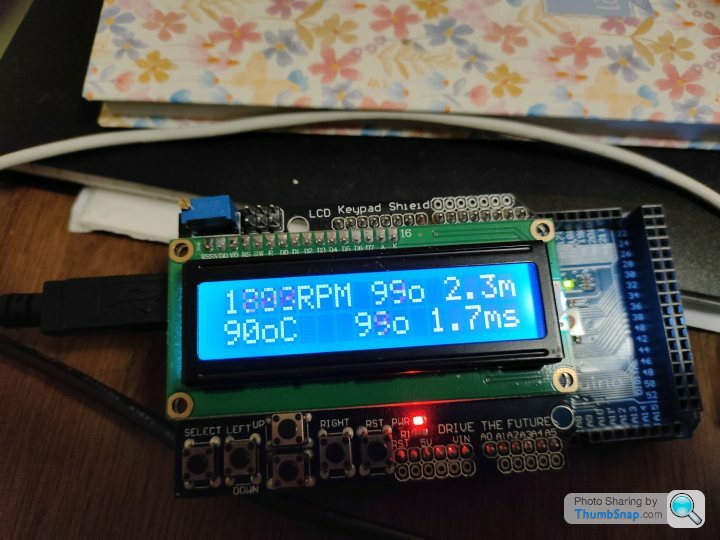
Penelope Stopit said:
Max relay current looks to be 8 Amps which is very likely to be far too low for powering window motors especially during motor start up and motor lock-up
No problems and good to have some input and yes your right even if the Arduino itself can't power the circuit as the relay isn't high enough current then we trigger another relay which does the same type of thing, just a bit more long windedThe actual boards I bought have a 10Amp at 24VDC relay on them and in this YouTube video where
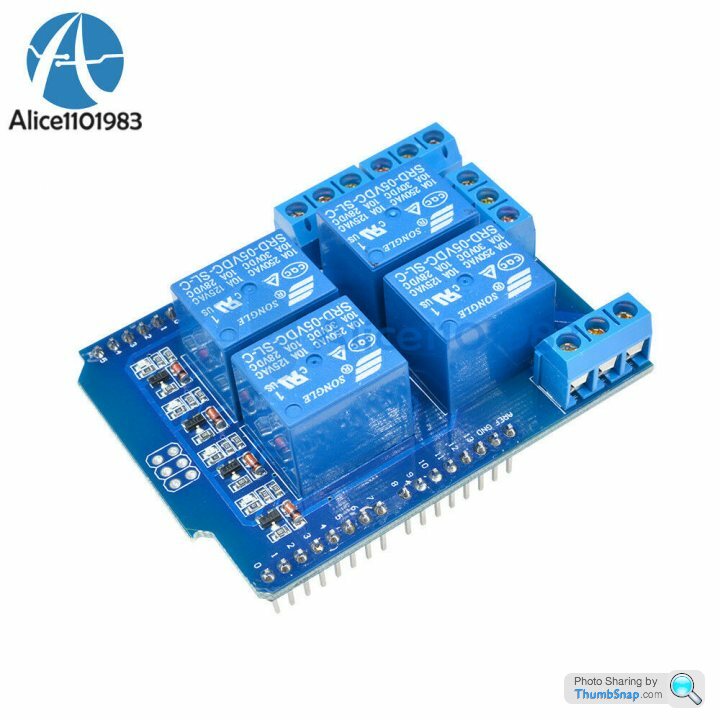

Still worth trying out and we'll see how well / slowly it works etc. or not
- Addendum -
Just checked my Door Control ECU PCB photos and the SCHRACK Relays are 10Amp rated, so those are probably the door latch, and door lock and because those are just pulsed I believe that should be fine with the 10Amp ones on the Arduino

Also, if you look at the bottom of the relay shield PCB, the tracks for the high current part, i.e. the relay, are much thicker than the normal tracks, so designed for this high current

The window relays I'm guessing are these 4 which are RTD14012 SPDT 16 A 12VDC so 16Amp rated so we might need to trigger equivalents of those separately
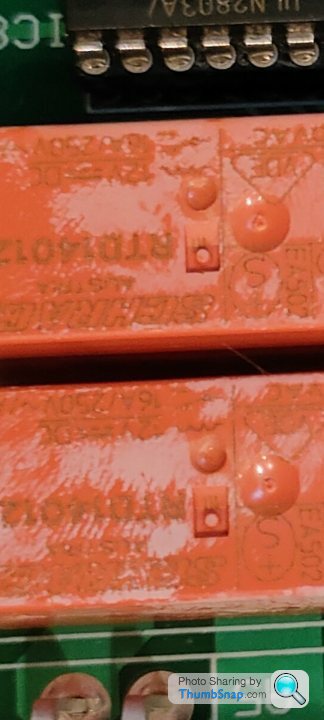
Edited by Juddder on Saturday 8th January 12:58
Gassing Station | Cerbera | Top of Page | What's New | My Stuff




